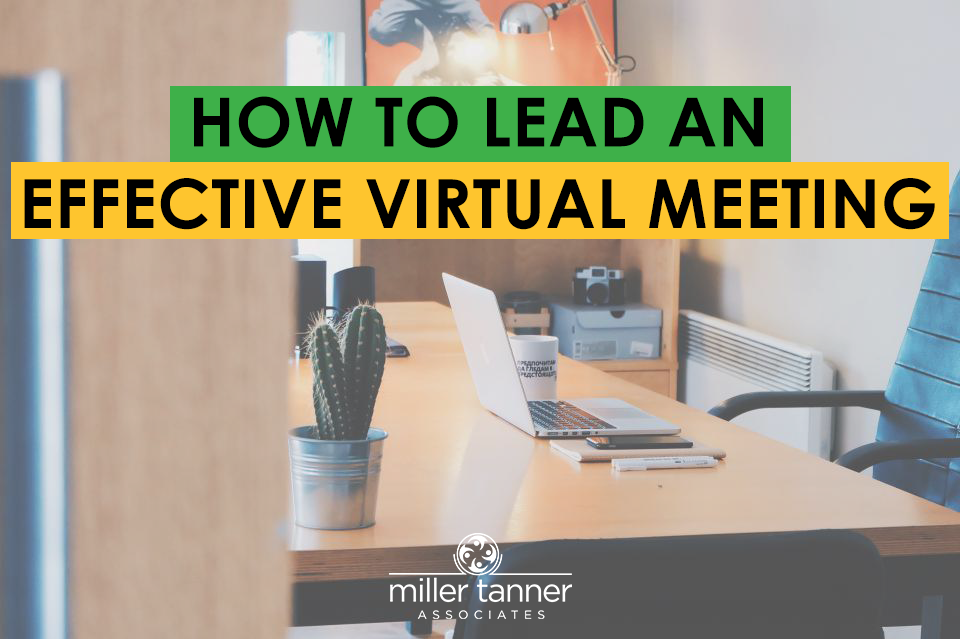At Miller Tanner, we’ve been producing virtual meetings for our clients for years. We’ve hosted hundreds of virtual meetings with participants from all over the world.
But while virtual meeting technology isn’t new to us, we know it’s still pretty new to a lot of companies out there. We get questions all the time from organizations considering dipping their toes in the virtual-meeting waters.
One of the most common questions we hear: What are best practices for successfully executing a virtual meeting?
In today’s post, we’ll answer that question by providing some practical tips to help you lead a successful virtual meeting.
Virtual meetings offer a number of key benefits that make them valuable to have in your event-planning toolbox. Let’s briefly touch on a trio of them:
- Cost – Going virtual can be an effective way to cut meeting costs. The per-person cost of a virtual meeting is roughly 10% of the cost for the same training at a face-to-face meeting.
- Convenience – Virtual meetings take the burden of travel off both attendees and presenters, allowing for efficient training with little impact on attendees’ and presenters’ busy schedules.
- Coverage – Because of reduced travel and greater flexibility, virtual meetings provide the opportunity to potentially reach more people than you could with a face-to-face meeting.
5 Tips for Hosting a Successful Virtual Meeting
Based on our experience, here are five things you can do to ensure your virtual meeting runs smoothly and makes an impact:
1. Communicate how the technology works ahead of time.
Technology plays a large role in a virtual meeting. The key lies in effectively communicating to attendees and presenters how the technology works. You’ll want to do this before the meeting starts to prevent any potential problems.
First, make sure your presenters are in a location with a strong Internet connection and provide them with alternative dial-in options should they not be able to use a headset/VoIP.
Second, provide a list of best practices to attendees prior to the meeting telling them important things to know like how to connect, best Internet speed, joining on VoIP or dial in, etc.
Finally, have your MC review key meeting features with attendees—like showing them how to submit questions, raise their hands, or download any handout materials—right before your meeting starts.
2. Educate your presenters on how to deliver information virtually.
A virtual presentation is a little different than a face-to-face presentation. It requires a different approach and familiarity with the technology so you can best use it to your advantage.
At Miller Tanner, one of the key things we do is provide USB headsets to our speakers for optimal audio quality during virtual meetings. Poor audio can really hurt a meeting and be a huge distraction.
We also provide meeting presenters with a pre-meeting technical rehearsal. This allows presenters to become comfortable with the meeting platform and learn and understand all of its functions/capabilities so they can use them effectively.
3. Make it a point to interact with virtual meeting participants.
One of the downsides of virtual meetings is that it can be easier for participants to check out and lose focus. Fortunately, today’s technology makes engaging your virtual audience a little easier.
For example, presenters can use live in-session polling questions to get immediate attendee feedback. On the other side, participants can submit questions either via text or by verbalizing questions with “hands raised” features.
These features serve to create a two-way street of communication and keep attendees involved. The key is using them regularly and making it a point to interact with participants throughout all your event sessions.
4. Leverage the medium to maximize attendance.
One of the great things about virtual meetings is they give you the flexibility to reach more people.
Think of Virtual Meetings as “multiples”. You can reach multiple countries and multiple time zones by hosting multiple meetings with the same content and presenters or providing multiple meeting dates.
It’s all based on choosing the best scenario for your meeting and the scheduling needs of your attendees and presenters.
That may mean hosting one meeting for multiple time zones across one country or setting up multiple replicated meetings on different days or times to allow attendees globally to hear the information.
5. Prepare and provide meeting content to reinforce messaging.
Give your participants a strong sense of your meeting content. That means providing as much supporting information as possible to keep attendees on-track, following along, and understanding key messages.
One important thing we do when working with clients is to create an agenda for the meeting that we provide to attendees ahead of time. This is crucial because attendees want to know what to expect and when to expect it.
We also have many clients that provide virtual “handouts” to participants before or during meetings, and many presenters use in-session polling to drive content and discussions.
Plan Ahead to Deliver a Valuable Virtual Meeting Experience
Virtual meetings can be an asset to any organization that regularly hosts events or training meetings. But delivering an engaging virtual event experience can be technically and logistically challenging.
Make sure you take the necessary steps ahead of time to ensure your virtual meeting is a professional and valuable experience for your attendees.
And remember, as with anything—the more virtual meetings you host, the better you’ll get at it. Practice makes perfect.
Need help unlocking the full potential of your virtual meetings? Talk to Miller Tanner today.


